Sudden dizziness, headache, blurred vision, limb numbness, beware of cerebral infarction

|
Lacunar infarction Many patients, especially middle-aged and elderly patients, undergo head CT or MRI examinations due to symptoms such as dizziness and headache. When they find "lacunar infarction" clearly written in the report, they often worry whether they have suffered cerebral infarction and whether they will become hemiplegic at any time. So, is lacunar infarction a cerebral infarction? Will lacunar infarction cause paralysis? Does lacunar infarction require treatment? … Next, let’s learn about lacunar infarction. What is lacunar infarction? The concept of lacunar infarction was first proposed by neurologist Fisher in 1965. It is a pathological concept that refers to small cavities in brain tissue found during pathological examination. It was later widely used by clinical and imaging physicians. Lacunar infarction refers to a tiny cerebral infarction lesion with a diameter of 2-15 mm, usually not exceeding 20 mm. It refers to a lacunar infarction lesion caused by occlusion of the lumen of the brain's perforating arteries or peripheral arteriolar vessels. It is more common in middle-aged and elderly people who have long-term underlying diseases such as hypertension and diabetes. The site of lacunar infarction is mostly located in a relatively quiet area of the brain, and most of them have no obvious neurological symptoms. It is often discovered during physical examinations and is also called silent cerebral infarction or asymptomatic infarction. The occurrence of lacunar infarction is often related to the walls of small arteries in the deep perforating branches of the brain caused by some uncontrollable risk factors such as age, race, gender, genetics, etc. and some controllable risk factors such as hypertension, diabetes, hyperlipidemia, smoking, etc. They develop chronically and develop luminal sclerosis, wall thickening, luminal stenosis and occlusion, or small thrombi blocking the perforating arteries, hemodynamic changes and other factors lead to vascular occlusion, and small cavities are formed after the brain tissue ischemic hypoxia liquefaction necrosis. Will lacunar infarction cause paralysis? Lacunar infarction is a special clinical subtype of cerebral infarction, but it is not equivalent to cerebral infarction. Most cases of lacunar infarction have no obvious clinical symptoms. If the lesions are located in functional and critical areas of the brain, they can cause obvious acute symptoms and signs, manifested as lacunar syndrome, including pure motor hemiplegia, pure sensory stroke, sensorimotor stroke, ataxia hemiplegia, and dysarthria-clumsy hand syndrome. Patients will have difficulty moving one side of the limbs with or without limb numbness, abnormal limb coordination such as unsteady walking, slurred speech with or without clumsy finger movements such as poor fine motor skills such as writing; if lacunar infarction lesions are multiple, they can also manifest as chronic onset, with gradual onset of symptoms and signs such as memory loss, mood changes, and abnormal gait. If lacunar infarction is only discovered during imaging examination , then there is no need to worry too much. This situation is asymptomatic cerebral infarction. The main way to deal with it is to screen for risk factors that may lead to lacunar infarction and manage risk factors. If there are obvious acute clinical symptoms, effective treatment is needed as soon as possible. Don't be overly afraid. The neurological deficit symptoms of lacunar infarction are relatively mild. After treatment, most people have a good prognosis and can return to normal work and life. Does lacunar infarction require treatment? For lacunar infarction with typical clinical symptoms, active treatment and medication are required, including antiplatelet drugs, plaque stabilizing drugs, drugs to control blood pressure, blood sugar, blood lipids, homocysteine, etc. Of course, lifestyle adjustments are the basis. If it is an asymptomatic lacunar infarction, it is also necessary to actively screen for risk factors such as the three highs to prevent problems before they occur. The prevention and control measures are: 1. Healthy lifestyle: low-salt (daily intake of no less than 6 g) low-fat diet, avoid overeating, quit smoking and limit alcohol, exercise regularly, have a regular work and rest schedule, control weight, maintain a positive mood, etc.; be alert to sudden changes in temperature and adjust clothing in time; 2. Screening and treatment of hypertension: Hypertension is a common cause of lacunar infarction. Strict control of hypertension is an important measure to prevent lacunar infarction. The treatment of hypertension requires long-term oral long-acting antihypertensive drugs and self-monitoring at different times of the day or on different days. It cannot be inferred based on the presence or absence of dizziness and headache symptoms. Try to control blood pressure within the normal range. For patients with cerebral vascular stenosis, blood pressure needs to be controlled within a relatively stable and safe range under the guidance of a neurologist. 3. Screening and treatment of diabetes: Strengthen the monitoring of fasting blood sugar, two hours after meals, and glycosylated hemoglobin, strictly control diet, especially reduce or avoid high-calorie or high-fat diet intake, and use drugs to control blood sugar within the standard range when necessary; 4. Screening and treatment of hyperlipidemia: For patients with mixed hyperlipidemia and carotid artery plaques, timely start statin treatment and monitor liver function to control blood lipids to meet standards; 5. Screening and treatment of hyperhomocysteinemia: supplementation of vitamin B6, vitamin B12 and folic acid; 6. Regularly undergo heart examinations to screen for abnormalities such as atrial fibrillation; 7. For patients with carotid artery plaque or stenosis, it is recommended to regularly review carotid artery color Doppler ultrasound and cerebral blood flow imaging to screen for vascular stenosis; 8. For patients with lacunar cerebral infarction with typical clinical symptoms, in addition to actively controlling risk factors, regular drug treatment targeting the cause should be carried out under the guidance of a specialist; 9. If you suddenly experience symptoms such as dizziness, headache, blurred vision, numbness and weakness in the limbs, unsteady walking, you should go to the hospital as soon as possible to complete a CT or MRI of the head. |
Recommend
Why does female vaginal discharge turn black?
As we all know, leucorrhea is a kind of secretion...
What should we do about chronic gynecological inflammation?
Gynecological diseases are relatively common for ...
Is breast swelling a sign of pregnancy?
Breast swelling is generally caused by many reaso...
62-year-old Fei Xiang has a lot of muscle! If you want to be healthy when you are old, do these three things!
"It's really impressive to be in good he...
What should I do if I have myopia in only one eye?
Many myopic friends have this question: Why are t...
Is it normal to have abdominal pain during ovulation?
Many women will experience various abnormal pheno...
How to care for your breasts
Girls pay great attention to the maintenance of t...
I didn't have my period but there was some blood
What women are most worried about is menstruation...
What to do if the amniotic fluid is not transparent
Poor amniotic fluid sound transmission refers to ...
Why do some people live for 3 months while others live for 30 years for the same lung cancer?
Why do some patients with lung cancer die within ...
How to get pregnant early
Pregnancy is an event that many women have to exp...
Food safety | Save food and oppose waste
Every meal is hard-earned. Consumers and catering...
Nielsen: Android market share increased from 40% to 43% from July to August 2011
On September 27, 2011, market research company Ni...
What is the freshness of sea bass? Nutritional value of sea bass
Sea bass contains nutrients such as protein, fat,...
Fallopian tube recanalization method
Fallopian tube blockage is a disease that causes ...






![[Facial Paralysis Science Series] Peripheral Facial Paralysis Illustrated Science - Say goodbye to facial paralysis and return to the "peak of beauty"](/upload/images/67f18f627e60a.webp)


